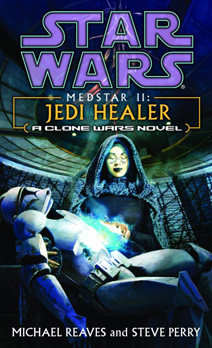While I disagree with the canceling of the Expanded Universe, one positive aspect of the new Disney canon is that all future projects will be connected to each other. On the other hand, part of the fun of the old system was seeing how the EU and canonical George Lucas projects sometimes accidentally fit together.
A prime example is the saga of Barriss Offee. In “MedStar II: Jedi Healer” (2004), she experiments with mixing the wonder drug bota with her Force abilities. She believes this could enhance her Jedi skills to such a degree that she could influence the outcome of the Battle of Drongar, and perhaps the entire Clone Wars. In the end, she decides she would be flirting with the dark side and it’s not worth the risk.
While the “Clone Wars” writers weren’t trying to tie into “MedStar,” it’s interesting to note that Barriss does indeed turn to the dark side in the final arc of Season 5. The two stories don’t link up flawlessly: In “Jedi Healer,” Barriss deals with traditional Jedi concerns about the allure of power; in “The Clone Wars,” she turns dark for political reasons in a parallel to what Anakin will later go through — she doesn’t trust the Jedi Order anymore. Also, she seems to become a Jedi Knight in the book and seems to still be a Padawan in the TV series. (However, it’s possible she is a Knight in the Season 5 arc; it’s never stated explicitly one way or another.)
As with “Battle Surgeons,” the first book in Michael Reaves’ and Steve Perry’s duology, “Jedi Healer” isn’t an essential read, but it is a fun hodgepodge of ideas with a pulp sci-fi appeal. It’s actually quite an accomplishment that “MedStar” doesn’t show us any battles – by ground or air – yet remains a tense, vibrant war novel in its medical-station setting. The hook is the colorful characters, who often meet up over a game of sabacc at the pub. Jos is part of an Amish-style Corellian subculture that doesn’t allow marriage outside the sect; he struggles with his love for Tolk. Sullustan Den Dhur fancies himself a cynical journalist but begins to care about his comrades. I-Five shows his humanity despite being a droid. Some of these characters will continue into Reaves’ “Coruscant Nights” books, and I’m looking forward to re-reading those.
A mystery also takes up a fair amount of pages, as a double-dealing Separatist and Black Sun spy is in the midst of the medical outpost. I enjoyed trying to puzzle out the spy’s identity. We also get a blatant villain, the Black Sun operative Kaird, who rather ridiculously has access to costumes that allow him to pass as various other species.
In the end, for all its intriguing elements, “Jedi Healer” – like a fair number of EU books – didn’t stick as part of the larger continuity, aside from Reaves carrying some characters into his “Coruscant Nights” books. The authors introduce the specific-to-Drongar wonder drug bota, but then establish that it is losing potency, thus putting a bow on the concept. The spy yarn is wrapped up with the death of the spy, although the spy’s motive is surprising: The Republic wiped out his home planet in an experiment gone wrong, and then covered it up. It’s intriguing to think of the Republic acting like the Empire this early in the game.

And Barriss, at least for now, is secure in the light side; if there had been synergy between projects, the authors could’ve established how her political views might’ve tempted her to cross a line.
So while the “MedStar” duology is enjoyable – especially for fans who don’t require the presence of main characters like Anakin or Obi-Wan – it’s no accident that it’s just a side show on a backwater planet.

